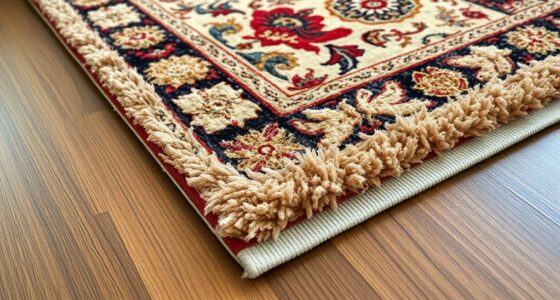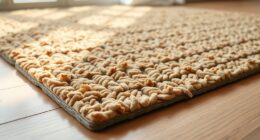To responsibly mothproof your silk carpet, avoid harsh chemicals and opt for natural remedies like cedar or lavender sachets, which are safe and eco-friendly. Regularly vacuum and inspect the carpet for signs of moth activity. Store it in a dry, well-ventilated area with breathable covers, and maintain proper humidity levels. Using gentle, biodegradable treatments and monitoring your carpet’s condition can keep it protected long-term—more tips await if you explore further.
Key Takeaways
- Use natural repellents like lavender, cedar, or eucalyptus to deter moths responsibly without damaging silk fibers.
- Regularly inspect and vacuum both sides of the carpet to remove eggs, larvae, and attractants effectively.
- Apply mothproofing agents in well-ventilated areas, following manufacturer instructions and conducting spot tests first.
- Store silk carpets in cool, dry, breathable environments with pest prevention measures like cedar blocks or lavender sachets.
- Opt for eco-friendly, biodegradable solutions and sustainable practices to preserve the carpet and protect the environment.
Understanding the Risks and Benefits of Mothproofing Silk Carpets
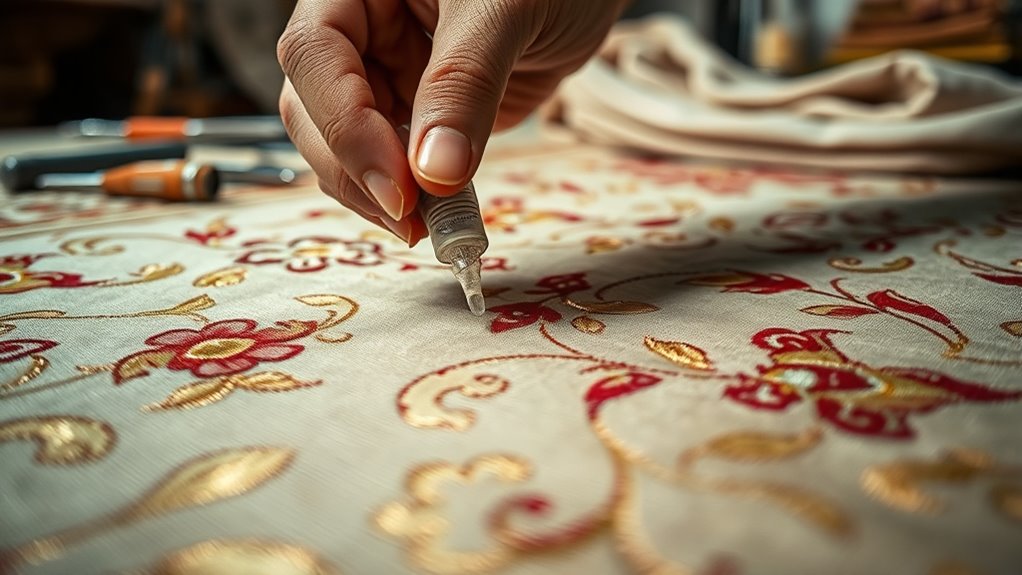
Mothproofing silk carpets can be highly beneficial, but it’s important to understand the potential risks involved. Chemical treatments used in DIY mothproofing can effectively deter pests but may also pose health risks if not applied correctly. Some products contain strong chemicals that could damage delicate silk fibers or cause allergic reactions. Before using chemical treatments, research thoroughly and follow manufacturer instructions carefully. Additionally, choosing appropriate protection methods can help minimize exposure to harmful substances. While DIY mothproofing offers a cost-effective solution, it’s essential to weigh these benefits against possible damage or health concerns. In some cases, improper application might weaken the fabric or leave residues that are hard to remove. Furthermore, understanding the role of attention in the application process can improve effectiveness and safety. Knowing the weight of the treatment and how it interacts with your silk carpet can also influence your choice of method. Additionally, understanding the contrast ratio of your treatment options can help you choose the most effective method. Incorporating proper storage techniques can further prevent moth infestations without chemical exposure. Being informed helps you make safer choices, ensuring your silk carpet remains beautiful and pest-free without unintended consequences.
Natural and Eco-Friendly Moth Repellents for Silk Fabrics

When you want to protect your silk carpets naturally, eco-friendly moth repellents offer a safe and effective alternative to chemical treatments. Biodegradable repellents break down naturally, reducing environmental impact while safeguarding your fabrics. Botanical sprays made from natural extracts like lavender, cedar, or eucalyptus are popular choices because they repel moths without harmful chemicals. These sprays are easy to apply and can be used regularly to maintain a moth-free environment. Using natural repellents minimizes the risk of chemical exposure to your family and pets, making them a healthier choice for your home. Unlike synthetic options, they won’t leave residues or damage delicate silk fibers. Choosing environmentally friendly repellents not only benefits the planet but also ensures your home remains safe for your family and pets. Incorporating AI in cybersecurity and other innovative solutions into your pest prevention routine can further enhance your efforts. By choosing natural repellents, you promote a healthier home and preserve your carpets’ beauty over time. Additionally, selecting repellents with biodegradable ingredients ensures they break down safely without harming the environment. Incorporating biodegradable repellents and botanical sprays into your moth prevention routine helps ensure your silk fabrics stay protected responsibly and sustainably.
Proper Cleaning and Maintenance to Prevent Moth Infestations
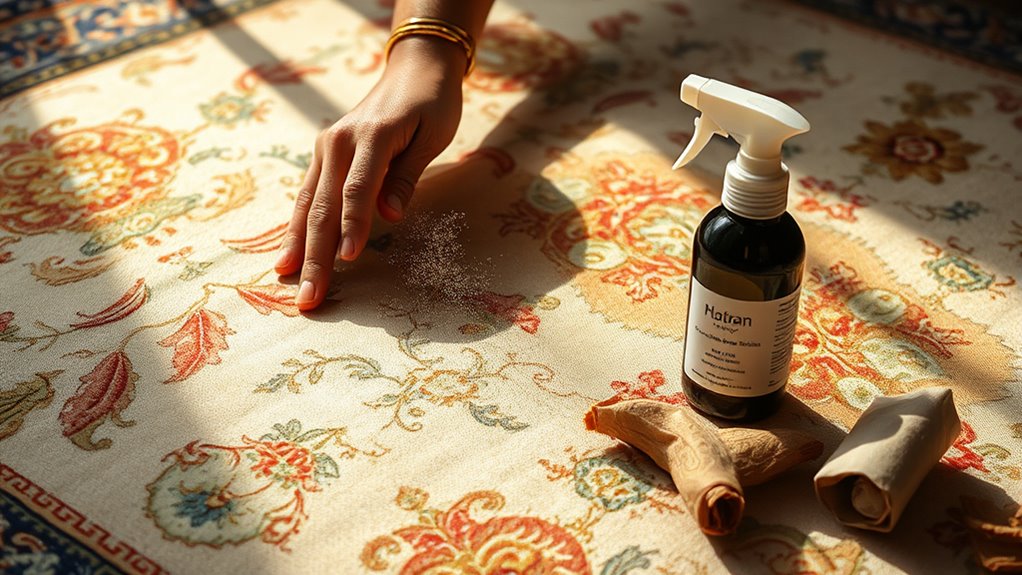
Regular cleaning and maintenance play an essential role in keeping moths away from your silk carpets. Using proper laundering techniques, such as gentle vacuuming regularly and spot cleaning spills immediately, removes food particles and lint that attract moths. Be sure to vacuum both sides of the carpet and the surrounding area to eliminate eggs and larvae. Pest monitoring is also vital—you should inspect your carpet frequently for signs of moth activity, like small holes or webbing. Consider setting up pheromone traps nearby to detect early infestations. Maintaining a clean environment reduces the likelihood of moths settling in. Proper home cleaning habits and vigilant pest monitoring help protect your silk carpets, preventing infestations before they start and ensuring your investment stays beautiful and moth-free. Additionally, maintaining optimal climate conditions in your home, such as controlling humidity levels, can further discourage moths from infesting your textiles. Implementing preventive measures like regular inspections can make a significant difference in early detection and control. Moreover, using modern heat pump technology can help regulate indoor temperatures and humidity, creating an environment less conducive to moth growth. Furthermore, understanding the life cycle of moths can aid in timing your preventative efforts more effectively.
Safe Storage Practices to Protect Silk Carpets During Off-Use Periods
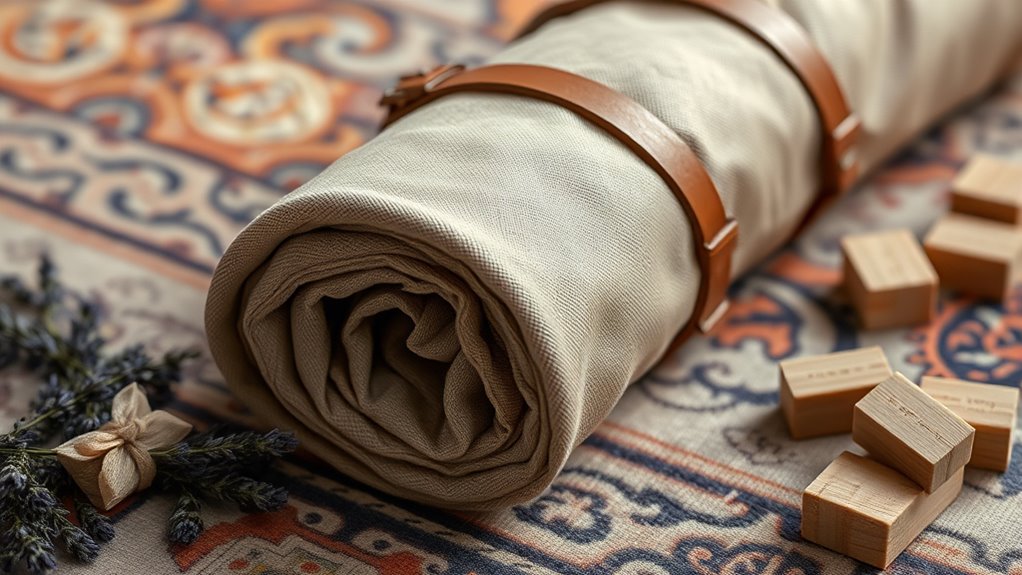
To effectively protect your silk carpets during periods of extended storage, it’s crucial to choose the right storage methods. Ensure your storage area is clean, dry, and well-ventilated to prevent mold and pest problems. Use breathable covers like cotton sheets instead of plastic, which can trap moisture and encourage pest activity. Incorporate pest prevention measures, such as cedar blocks or lavender sachets, to deter moths and insects. Keep the storage area safe by avoiding direct sunlight, extreme temperatures, and humidity, which can damage silk fibers. Regularly inspect your stored carpet for signs of pests or deterioration, and handle it carefully to prevent accidental damage. Proper storage safety and pest prevention are key to maintaining your silk carpet’s beauty and longevity during off-use periods. Additionally, utilizing HEPA filtration air purifiers in your storage space can help reduce airborne particles and protect delicate fabrics from dust and allergens. Implementing climate control systems can further ensure consistent conditions, preventing damage caused by fluctuating temperatures and humidity. Incorporating remote monitoring systems can also assist in maintaining optimal storage conditions for your valuable textiles. Regular cleaning and conditioning of the storage environment can further enhance silk preservation by reducing dust accumulation and maintaining stable conditions.
Sustainable Methods for Long-Term Protection and Care
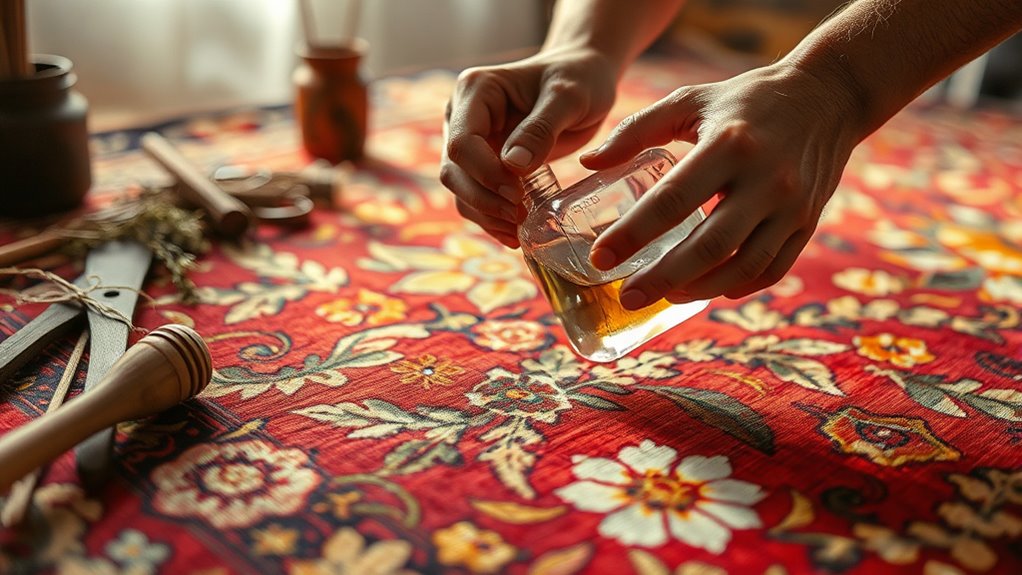
After ensuring your silk carpet is stored properly, adopting sustainable methods for long-term protection and care can extend its beauty and durability. Use eco-conscious treatments that are gentle yet effective, avoiding harsh chemicals that may harm the fibers or the environment. Biodegradable solutions are an excellent choice, as they break down naturally without leaving harmful residues. Regularly vacuum your carpet with a HEPA filter to remove dust and potential pests, reducing the need for chemical mothproofing agents. Consider natural repellents like cedar or lavender, which are both eco-friendly and safe for silk. These sustainable practices not only protect your investment but also promote a healthier environment, ensuring your silk carpet remains vibrant and intact for years to come.
Frequently Asked Questions
How Often Should I Reapply Mothproofing Treatments on Silk Carpets?
You should reapply mothproofing treatments on your silk carpet every 6 to 12 months. The application frequency depends on factors like exposure to sunlight, humidity, and foot traffic. Regular reapplication helps maintain protection, ensuring your carpet stays moth-free and extends its longevity. Keep an eye on signs of wear or moth activity, and reapply as needed to preserve the beauty and durability of your silk carpet over time.
Can Mothproofing Treatments Affect the Color or Texture of Silk?
Like a knight in shining armor, mothproofing treatments protect your silk carpets, but they can influence color preservation and texture impact. Some products may cause slight fading or alter the feel of the silk, so always choose gentle, silk-safe options. Test a small area first, and follow manufacturer instructions closely. Proper application ensures your carpet stays vibrant and maintains its soft, luxurious texture over time.
Are There Any Specific Environmental Conditions That Enhance Mothproofing Effectiveness?
To enhance mothproofing effectiveness, focus on controlling humidity and limiting sunlight exposure. Keep the environment dry, as high humidity attracts moths, while too much sunlight can weaken silk fibers. Use dehumidifiers and guarantee proper ventilation to maintain ideal moisture levels. Store your silk carpets in cool, dark places, and regularly check for signs of pests. These steps help preserve both the integrity and moth resistance of your silk carpets.
What Are Signs of Moth Damage or Infestation in Silk Carpets?
When it comes to silk carpets, spotting signs of infestation is vital before damage worsens. Look for tiny holes, silk fraying, or larvae clusters—these indicate silk carpet damage caused by moths. You might also see shed skins or a musty odor. Don’t wait until it’s too late; early detection helps prevent more extensive moth damage. Keep a close eye, and you’ll catch problems before they spin out of control.
How Can I Safely Remove Mothproofing Residues From Silk Without Damage?
To safely remove mothproofing residues from silk, you should avoid harsh chemicals. Instead, try natural remedies or DIY solutions like gently vacuuming the carpet with a soft brush attachment. You can also lightly dab a cloth with diluted white vinegar or mild soap, testing in a small area first. These methods help eliminate residues without damaging the delicate silk fibers, ensuring your carpet stays beautiful and protected.
Conclusion
By choosing responsible mothproofing methods, you protect your cherished silk carpets without harming the environment. While chemical treatments may seem quick and effective, they often come at the cost of your health and the planet’s wellbeing. Embrace natural solutions and proper care, and you’ll preserve the beauty of your carpets for generations to come. In safeguarding your treasures, you also nurture a sustainable future—because true responsibility lies in love, care, and mindful choices.




